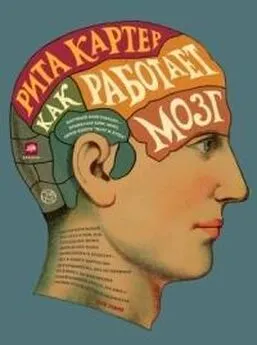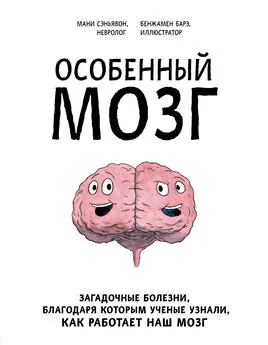Дин Бернетт - Счастливый мозг. Как работает мозг и откуда берется счастье
- Название:Счастливый мозг. Как работает мозг и откуда берется счастье
- Автор:
- Жанр:
- Издательство:Эксмо
- Год:2018
- Город:Москва
- ISBN:978-5-04-095041-6
- Рейтинг:
- Избранное:Добавить в избранное
-
Отзывы:
-
Ваша оценка:
Дин Бернетт - Счастливый мозг. Как работает мозг и откуда берется счастье краткое содержание
Счастливый мозг. Как работает мозг и откуда берется счастье - читать онлайн бесплатно ознакомительный отрывок
Интервал:
Закладка:
Джерри Спрингер (род. 1944) – британский актер, продюсер, телеведущий и политик; «Шоу Джерри Спрингера» затрагивало скандальные темы и отличалось грубостью и драками среди участников (прим. ред.).
1
Burnett, D., Role of the hippocampus in configural learning. 2010: Cardiff University (United Kingdom).
2
Arias-Carrion, O. and E. Poppel, Dopamine, learning, and reward-seeking behavior. Acta Neurobiol Exp (Wars), 2007. 67 (4): p. 481–488.
3
Zald, D. H., et al., Midbrain dopamine receptor availability is inversely associated with novelty-seeking traits in humans. The Journal of Neuroscience, 2008. 28 (53): p. 14372–14378.
4
Bardo, M. T., R. L. Donohew, and N. G. Harrington, Psychobiology of novelty seeking and drug seeking behavior. Behavioural Brain Research, 1996. 77 (1): p. 23–43.
5
Berns, G. S., et al., Predictability modulates human brain response to reward. Journal of neuroscience, 2001. 21 (8): p. 2793–2798.
6
Hawkes, C., Endorphins: the basis of pleasure? Journal of Neurology, Neurosurgery & Psychiatry, 1992. 55 (4): p. 247–250.
7
Pert, C. B. and S. H. Snyder, Opiate receptor: demonstration in nervous tissue. Science, 1973. 179 (4077): p. 1011–1014.
8
Lyon, A. R., et al., Stress (Takotsubo) cardiomyopathy – a novel pathophysiological hypothesis to explain catecholamine-induced acute myocardial stunning. Nature Reviews. Cardiology, 2008. 5 (1): p. 22.
9
Okur, H., et al., Relationship between release of beta-endorphin, cortisol, and trauma severity in children with blunt torso and extremity trauma. J Trauma, 2007. 62 (2): p. 320–324; discussion 324.
10
Esch, T. and G. B. Stefano, The neurobiology of stress management. Neuro Endocrinol Lett, 2010. 31 (1): p. 19–39.
11
Weizman, R., et al., Immunoreactive [beta] -Endorphin, Cortisol, and Growth Hormone Plasma Levels in Obsessive-Compulsive Disorder. Clinical Neuropharmacology, 1990. 13 (4): p. 297–302.
12
Galbally, M., et al., The role of oxytocin in mother-infant relations: a systematic review of human studies. Harv Rev Psychiatry, 2011. 19 (1): p. 1–14.
13
Renfrew, M.J., S. Lang, and M. Woolridge, Oxytocin for promoting successful lactation. Cochrane Database Syst Rev, 2000 (2): p. Cd000156.
14
Scheele, D., et al., Oxytocin modulates social distance between males and females. The Journal of Neuroscience, 2012. 32 (46): p. 16074–16079.
15
De Dreu, C.K., et al., Oxytocin promotes human ethnocentrism. Proceedings of the National Academy of Sciences, 2011. 108 (4): p. 1262–1266.
16
Dayan, P. and Q. J. Huys, Serotonin, inhibition, and negative mood. PLoS computational biology, 2008. 4 (2): p. e4.
17
Harmer, C.J., G. M. Goodwin, and P. J. Cowen, Why do antidepressants take so long to work? A cognitive neuropsychological model of antidepressant drug action. The British Journal of Psychiatry, 2009. 195 (2): p. 102–108.
18
Jorgenson, L.A., et al., The BRAIN Initiative: developing technology to catalyse neuroscience discovery. Phil. Trans. R. Soc. B, 2015. 370 (1668): p. 20140164.
19
Zivkovic, M., Brain Culture: Neuroscience and Popular Media. 2015, Taylor & Francis.
20
Pearl, S., Species, Serpents, Spirits, and Skulls: Science at the Margins in the Victorian Age, by Sherrie Lynne Lyons. Victorian Studies, 2010. 53 (1): p. 141–143.
21
Greenblatt, S.H., Phrenology in the science and culture of the 19th century. Neurosurgery, 1995. 37 (4): p. 790–804; discussion 804–805.
22
Sample, I. Updated map of the human brain hailed as a scientific tour de force. 2016 2016–07–20; Available from: http://www.theguardian.com/science/2016/jul/20/updated-map-of-the-human-brain-hailed-as-a-scientific-tour-de-force.
23
Aggleton, E.J.P., et al., The amygdala: a functional analysis. 2000.
24
Oonishi, S., et al., Influence of subjective happiness on the prefrontal brain activity: an fNIRS study, in Oxygen transport to tissue XXXVI. 2014, Springer. p. 287–293.
25
Kringelbach, M.L. and K. C. Berridge, The Neuroscience of Happiness and Pleasure. Social research, 2010. 77 (2): p. 659–678.
26
Berridge, K.C. and M. L. Kringelbach, Towards a Neuroscience of Well-Being: Implications of Insights from Pleasure Research, in Human Happiness and the Pursuit of Maximization: Is More Always Better? H. Brockmann and J. Delhey, Editors. 2013, Springer Netherlands: Dordrecht. p. 81–100.
27
Witek, M.A., et al., Syncopation, body-movement and pleasure in groove music. PloS one, 2014. 9 (4): p. e94446.
28
Zhou, L. and J. A. Foster, Psychobiotics and the gut-brain axis: in the pursuit of happiness. Neuropsychiatr Dis Treat, 2015. 11: p. 715–723.
29
Foster, J.A. and K. – A. M. Neufeld, Gut – brain axis: how the microbiome influences anxiety and depression. Trends in neurosciences, 2013. 36 (5): p. 305–312.
30
Aschwanden, C. How Your Gut Affects Your Mood | FiveThirtyEight. 2016 2016–05–19T11:00:05+00:00; Available from: https://fivethirtyeight.com/features/gut-week-gut-brain-axis-can-fixing-my-stomach-fix-me/.
31
Chambers, C., The seven deadly sins of psychology: A manifesto for reforming the culture of scientific practice. 2017: Princeton University Press.
32
Cohen, J., The statistical power of abnormal-social psychological research: a review. The Journal of Abnormal and Social Psychology, 1962. 65 (3): p. 145.
33
Engber, D., Sad Face: Another Classic Psychology Finding – That You Can Smile Your Way to Happiness – Just Blew Up. 2016, Slate: slate.com.
34
Raderschall, C.A., R. D. Magrath, and J. M. Hemmi, Habituation under natural conditions: model predators are distinguished by approach direction. The Journal of Experimental Biology, 2011. 214 (24): p. 4209.
35
Oswald, I., Falling Asleep Open-eyed During Intense Rhythmic Stimulation. British Medical Journal, 1960. 1 (5184): p. 1450–1455.
36
Schultz, W., Multiple reward signals in the brain. Nature reviews. Neuroscience, 2000. 1 (3): p. 199.
37
Almeida, T.F., S. Roizenblatt, and S. Tufik, Afferent pain pathways: a neuroanatomical review. Brain research, 2004. 1000 (1): p. 40–56.
38
Dickinson, A. and N. Mackintosh, Classical conditioning in animals. Annual review of psychology, 1978. 29 (1): p. 587–612.
39
Parasuraman, R. and S. Galster, Sensing, assessing, and augmenting threat detection: behavioral, neuroimaging, and brain stimulation evidence for the critical role of attention. Frontiers in Human Neuroscience, 2013. 7: p. 273.
40
Larson, C.L., et al., Recognizing Threat: A Simple Geometric Shape Activates Neural Circuitry for Threat Detection. Journal of Cognitive Neuroscience, 2008. 21 (8): p. 1523–1535.
41
Durham, R.C. and A. A. Turvey, Cognitive therapy vs behaviour therapy in the treatment of chronic general anxiety. Behaviour research and therapy, 1987. 25 (3): p. 229–234.
42
Szekely, A., S. Rajaram, and A. Mohanty, Context learning for threat detection. Cognition and Emotion, 2016: p. 1–18.
43
Suitor, J.J. and K. Pillemer, The Presence of Adult Children: A Source of Stress for Elderly Couples’ Marriages? Journal of Marriage and Family, 1987. 49 (4): p. 717–725.
44
Dinges, D.F., et al., Cumulative sleepiness, mood disturbance, and psychomotor vigilance performance decrements during a week of sleep restricted to 4–5 hours per night. Sleep, 1997. 20 (4): p. 267–277.
45
Agnew, H.W., W. B. Webb, and R. L. Williams, The First Night Effect: An EEG Study of Sleep. Psychophysiology, 1966. 2 (3): p. 263–266.
46
Sample, I., Struggle to sleep in a strange bed? Scientists have uncovered why. 2016, @guardian.
47
Burt, W.H., Territoriality and home range concepts as applied to mammals. Journal of mammalogy, 1943. 24 (3): p. 346–352.
48
Eichenbaum, H., The role of the hippocampus in navigation is memory. J Neurophysiol, 2017. 117 (4): p. 1785–1796.
49
Hartley, T., et al., Space in the brain: how the hippocampal formation supports spatial cognition. Philosophical Transactions of the Royal Society B: Biological Sciences, 2013. 369 (1635).
50
Jacobs, J., et al., Direct recordings of grid-like neuronal activity in human spatial navigation. Nature neuroscience, 2013. 16 (9): p. 1188–1190.
51
Rowe, W.B., et al., Reactivity to novelty in cognitively-impaired and cognitively-unimpaired aged rats and young rats. Neuroscience, 1998. 83 (3): p. 669–680.
52
Travaini, A., et al., Evaluation of neophobia and its potential impact upon predator control techniques: a study on two sympatric foxes in southern Patagonia. Behav Processes, 2013. 92: p. 79–87.
53
Misslin, R. and M. Cigrang, Does neophobia necessarily imply fear or anxiety? Behavioural processes, 1986. 12 (1): p. 45–50.
54
Quintero, E., et al., Effects of context novelty vs. familiarity on latent inhibition with a conditioned taste aversion procedure. Behavioural processes, 2011. 86 (2): p. 242–249.
55
Brocklin, E.V., The Science of Homesickness. 2014, Duke Alumni.
56
Bhugra, D. and M. A. Becker, Migration, cultural bereavement and cultural identity. World psychiatry, 2005. 4 (1): p. 18–24.
57
Silove, D., P. Ventevogel, and S. Rees, The contemporary refugee crisis: an overview of mental health challenges. World Psychiatry, 2017. 16 (2): p. 130–139.
58
Holmes, T., Rahe R. Holmes-Rahe life changes scale. Journal of psychosomatic research, 1967. 11: p. 213–218.
59
Zhang, R., T. J. Brennan, and A. W. Lo, The origin of risk aversion. Proceedings of the National Academy of Sciences, 2014. 111 (50): p. 17777–17782.
60
Ickes, B.R., et al., Long-term environmental enrichment leads to regional increases in neurotrophin levels in rat brain. Experimental neurology, 2000. 164 (1): p. 45–52.
61
Young, D., et al., Environmental enrichment inhibits spontaneous apoptosis, prevents seizures and is neuroprotective. Nature medicine, 1999. 5 (4).
Читать дальшеИнтервал:
Закладка:










